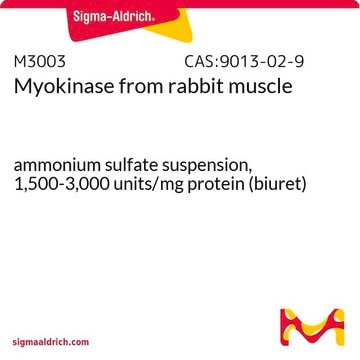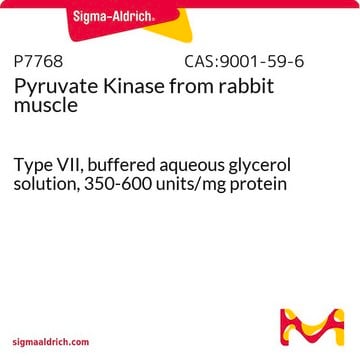P4390
Polynucleotide Kinase from T4-infected Escherichia coli
10 units/μL, buffered aqueous glycerol solution
About This Item
Recommended Products
grade
for molecular biology
form
buffered aqueous glycerol solution
mol wt
33 kDa
concentration
10 units/μL
foreign activity
Endonuclease and exonuclease, none detected
shipped in
wet ice
storage temp.
−20°C
Looking for similar products? Visit Product Comparison Guide
Application
- Sequencing or nucleic acid tagging (DNA and RNA) by 5′-end labeling
- 5′ phosphorylation of oligonucleotides
- Removal of 3′-phosphate groups from phosphorylpolynucleotides
Components
Principle
1. Forward reaction: Transfer of the labeled γ-phosphate from [γ-32P]-ATP to the free 5′-hydroxyl group of the substrate.
5′-HO-DNA + [γ-32P]-ATP → 5′-32PO-DNA + ADP.
Substrates that do not have a free 5′-hydroxyl require prior dephosphorylation by alkaline phosphatase.
2. Exchange reaction: First, the terminal 5′-phosphate is transferred from the substrate to ADP present in the reaction mixture. Then, the labeled γ-phosphate from [γ-32P]-ATP is transferred to the free hydroxyl group of the substrate.
5′-PO-DNA + ADP → 5′-HO-DNA + ATP
5′-HO-DNA + [γ-32P]-ATP → 5′-32PO-DNA + ADP
Unit Definition
Analysis Note
related product
signalword
Danger
hcodes
pcodes
Hazard Classifications
Resp. Sens. 1
Storage Class
10 - Combustible liquids
wgk_germany
WGK 3
flash_point_f
Not applicable
flash_point_c
Not applicable
ppe
Eyeshields, Gloves, multi-purpose combination respirator cartridge (US)
Certificates of Analysis (COA)
Search for Certificates of Analysis (COA) by entering the products Lot/Batch Number. Lot and Batch Numbers can be found on a product’s label following the words ‘Lot’ or ‘Batch’.
Already Own This Product?
Find documentation for the products that you have recently purchased in the Document Library.
Our team of scientists has experience in all areas of research including Life Science, Material Science, Chemical Synthesis, Chromatography, Analytical and many others.
Contact Technical Service







